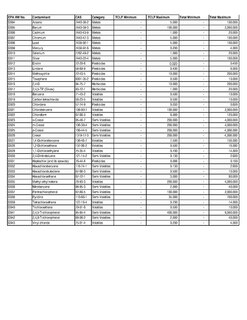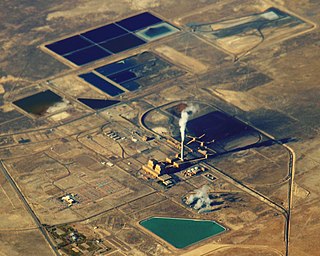
Hazardous waste is waste that has substantial or potential threats to public health or the environment. Hazardous waste is a type of dangerous goods. They usually have one or more of the following hazardous traits:ignitability, reactivity, corrosivity, toxicityListed hazardous wastes are materials specifically listed by regulatory authorities as hazardous wastes which are from non-specific sources, specific sources, or discarded chemical products. Hazardous wastes may be found in different physical states such as gaseous, liquids, or solids. A hazardous waste is a special type of waste because it cannot be disposed of by common means like other by-products of our everyday lives. Depending on the physical state of the waste, treatment and solidification processes might be required.

Industrial waste is the waste produced by industrial activity which includes any material that is rendered useless during a manufacturing process such as that of factories, mills, and mining operations. Types of industrial waste include dirt and gravel, masonry and concrete, scrap metal, oil, solvents, chemicals, scrap lumber, even vegetable matter from restaurants. Industrial waste may be solid, semi-solid or liquid in form. It may be hazardous waste or non-hazardous waste. Industrial waste may pollute the nearby soil or adjacent water bodies, and can contaminate groundwater, lakes, streams, rivers or coastal waters. Industrial waste is often mixed into municipal waste, making accurate assessments difficult. An estimate for the US goes as high as 7.6 billion tons of industrial waste produced annually, as of 2017. Most countries have enacted legislation to deal with the problem of industrial waste, but strictness and compliance regimes vary. Enforcement is always an issue.

Toxic waste is any unwanted material in all forms that can cause harm. Many of today's household products such as televisions, computers and phones contain toxic chemicals that can pollute the air and contaminate soil and water. Disposing of such waste is a major public health issue.

The Resource Conservation and Recovery Act (RCRA), enacted in 1976, is the principal federal law in the United States governing the disposal of solid waste and hazardous waste.

Toxicity characteristic leaching procedure (TCLP) is a soil sample extraction method for chemical analysis employed as an analytical method to simulate leaching through a landfill. The testing methodology is used to determine if a waste is characteristically hazardous, i.e., classified as one of the "D" listed wastes by the U.S. Environmental Protection Agency (EPA). The extract is analyzed for substances appropriate to the protocol.

Illegal dumping, also called fly dumping or fly tipping (UK), is the dumping of waste illegally instead of using an authorized method such as curbside collection or using an authorized rubbish dump. It is the illegal deposit of any waste onto land, including waste dumped or tipped on a site with no license to accept waste. The United States Environmental Protection Agency developed a “profile” of the typical illegal dumper. Characteristics of offenders include local residents, construction and landscaping contractors, waste removers, scrap yard operators, and automobile and tire repair shops.
According to the United States Environmental Protection Agency, mixed waste (MW) is a waste type defined as follows; "MW contains both hazardous waste and radioactive waste. It is jointly regulated by NRC or NRC's Agreement States and EPA or EPA's RCRA Authorized States. The fundamental and most comprehensive statutory definition is found in the Federal Facilities Compliance Act (FFCA) where Section 1004(41) was added to RCRA: "The term 'mixed waste' means waste that contains both hazardous waste and source, special nuclear, or byproduct material subject to the Atomic Energy Act of 1954."
Hazardous Waste Operations and Emergency Response is a set of guidelines produced and maintained by the Occupational Safety and Health Administration which regulates hazardous waste operations and emergency services in the United States and its territories. With these guidelines, the U.S. government regulates hazardous wastes and dangerous goods from inception to disposal.

Household hazardous waste (HHW) was a term coined by Dave Galvin from Seattle, Washington in 1982 as part of the fulfillment of a US EPA grant. This new term was reflective of the recent passage of the Resource Conservation and Recovery Act of 1976 in the US. This act and subsequent regulations strengthened the environmental protection requirements for landfills, in Subpart D, and created a "cradle to grave" management system for hazardous wastes, in Subpart C. From RCRA 1976 the US EPA promulgated rules in 1980 which explicitly excluded any wastes from household origins from regulation as a hazardous waste at the federal level. Most US states adopted parallel regulations to RCRA 1976 but were allowed to be more stringent. California took advantage of this allowance and chose to not exempt household origin wastes from their state hazardous waste laws. HHW products exhibit many of the same dangerous characteristics as fully regulated hazardous waste which are their potential for reactivity, ignitability, corrosivity, toxicity, or persistence. Examples include drain cleaners, oil paint, motor oil, antifreeze, fuel, poisons, pesticides, herbicides and rodenticides, fluorescent lamps, lamp ballasts containing PCBs, some smoke detectors, and in some states, consumer electronics. Except for California, most states exclude HHW from their hazardous waste regulations and regulate the management of HHW largely under their solid waste regulatory schemes.
Title 40 is a part of the United States Code of Federal Regulations. Title 40 arranges mainly environmental regulations that were promulgated by the US Environmental Protection Agency (EPA), based on the provisions of United States laws. Parts of the regulation may be updated annually on July 1.

In the United States, several federal agencies and laws have some jurisdiction over pollution from ships in U.S. waters. States and local government agencies also have responsibilities for ship-related pollution in some situations.

Municipal solid waste (MSW) – more commonly known as trash or garbage – consists of everyday items people use and then throw away, such as product packaging, grass clippings, furniture, clothing, bottles, food scraps and papers. In 2018, Americans generated about 292.4 million short tons (265.3 Mt) of trash. In the United States, landfills are regulated by the Environmental Protection Agency (EPA) and the states' environmental agencies. Municipal solid waste landfills (MSWLF) are required to be designed to protect the environment from contaminants that may be present in the solid waste stream.

An ash pond, also called a coal ash basin or surface impoundment, is an engineered structure used at coal-fired power stations for the disposal of two types of coal combustion products: bottom ash and fly ash. The pond is used as a landfill to prevent the release of ash into the atmosphere. Although the use of ash ponds in combination with air pollution controls decreases the amount of airborne pollutants, the structures pose serious health risks for the surrounding environment.

Waste management laws govern the transport, treatment, storage, and disposal of all manner of waste, including municipal solid waste, hazardous waste, and nuclear waste, among many other types. Waste laws are generally designed to minimize or eliminate the uncontrolled dispersal of waste materials into the environment in a manner that may cause ecological or biological harm, and include laws designed to reduce the generation of waste and promote or mandate waste recycling. Regulatory efforts include identifying and categorizing waste types and mandating transport, treatment, storage, and disposal practices.
Solid waste policy in the United States is aimed at developing and implementing proper mechanisms to effectively manage solid waste. For solid waste policy to be effective, inputs should come from stakeholders, including citizens, businesses, community-based organizations, non-governmental organizations, government agencies, universities, and other research organizations. These inputs form the basis of policy frameworks that influence solid waste management decisions. In the United States, the Environmental Protection Agency (EPA) regulates household, industrial, manufacturing, and commercial solid and hazardous wastes under the 1976 Resource Conservation and Recovery Act (RCRA). Effective solid waste management is a cooperative effort involving federal, state, regional, and local entities. Thus, the RCRA's Solid Waste program section D encourages the environmental departments of each state to develop comprehensive plans to manage nonhazardous industrial and municipal solid waste.

Mercury regulation in the United States limit the maximum concentrations of mercury (Hg) that is permitted in air, water, soil, food and drugs. The regulations are promulgated by agencies such as the Environmental Protection Agency (EPA) and Food and Drug Administration (FDA), as well as a variety of state and local authorities. EPA published the Mercury and Air Toxics Standards (MATS) regulation in 2012; the first federal standards requiring power plants to limit emissions of mercury and other toxic gases.

There are many exemptions for hydraulic fracturing under United States federal law: the oil and gas industries are exempt or excluded from certain sections of a number of the major federal environmental laws. These laws range from protecting clean water and air, to preventing the release of toxic substances and chemicals into the environment: the Clean Air Act, Clean Water Act, Safe Drinking Water Act, National Environmental Policy Act, Resource Conservation and Recovery Act, Emergency Planning and Community Right-to-Know Act, and the Comprehensive Environmental Response, Compensation, and Liability Act, commonly known as Superfund.

The Solid Waste Disposal Act (SWDA), is an Act of Congress passed in 1965. The United States Environmental Protection Agency described the Act as "the first federal effort to improve waste disposal technology". After the Second Industrial Revolution, expanding industrial and commercial activity across the nation, accompanied by increasing consumer demand for goods and services, led to an increase in solid waste generation by all sectors of the economy. The act established a framework for states to better control solid waste disposal and set minimum safety requirements for landfills. In 1976 Congress determined that the provisions of SWDA were insufficient to properly manage the nation's waste and enacted the Resource Conservation and Recovery Act (RCRA). Congress passed additional major amendments to SWDA in the Hazardous and Solid Waste Amendments of 1984 (HSWA).
Water in Arkansas is an important issue encompassing the conservation, protection, management, distribution and use of the water resource in the state. Arkansas contains a mixture of groundwater and surface water, with a variety of state and federal agencies responsible for the regulation of the water resource. In accordance with agency rules, state, and federal law, the state's water treatment facilities utilize engineering, chemistry, science and technology to treat raw water from the environment to potable water standards and distribute it through water mains to homes, farms, business and industrial customers. Following use, wastewater is collected in collection and conveyance systems, decentralized sewer systems or septic tanks and treated in accordance with regulations at publicly owned treatment works (POTWs) before being discharged to the environment.

Coal ash, also known as coal combustion residuals (CCRs), is the mineral residue that remains from burning coal. Exposure to coal ash and to the toxic substances it contains may pose a health risk to workers in coal-fired power plants and residents living near coal ash disposal sites.













